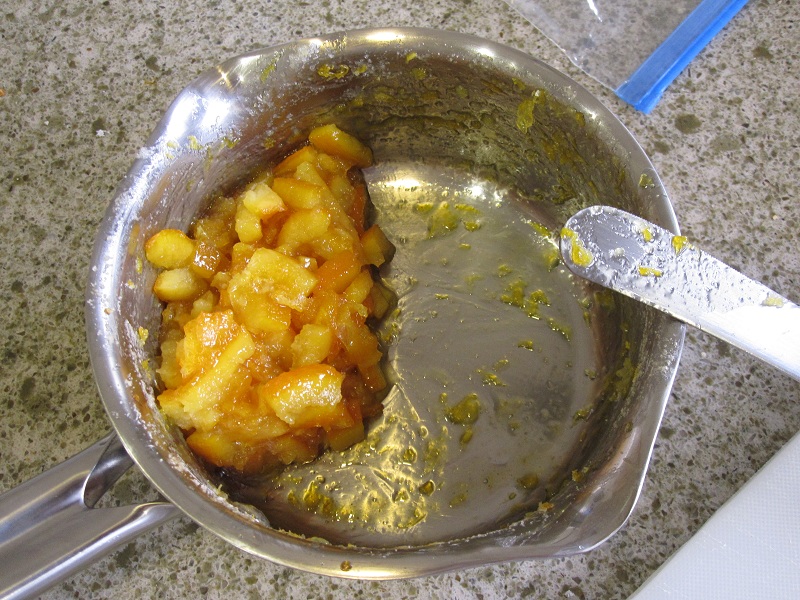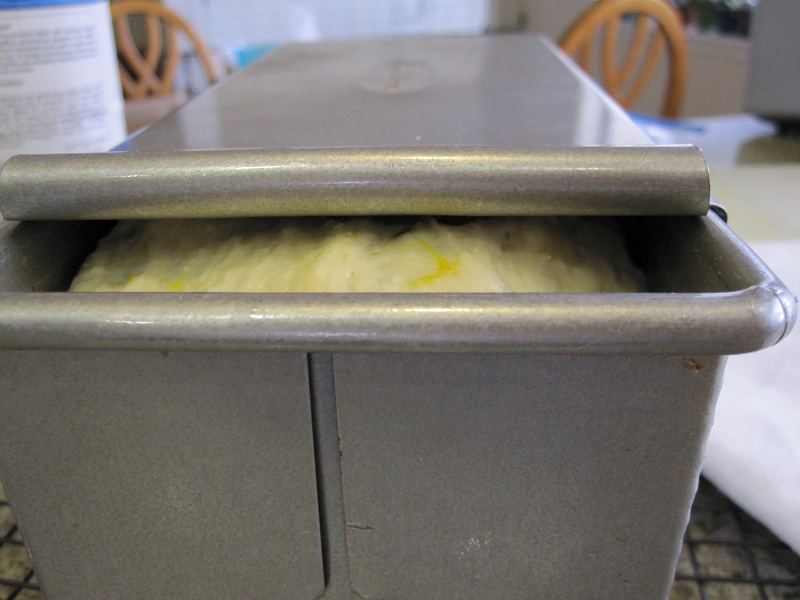I made another loaf of my orange-raisin bread and refined my working recipe a bit, adding weights and some specifics on the marmalade step.
My working recipe is now as follows:
====================================
Orange Raisin Bread
Ingredients:
about 200g of Home-made marmalade, made (see procedure below) from
about 200g = 1 smallish seedless navel orange and
100g = 1/2 cup granulated white sugar
~8g = 1 tablespoon SAF "red" instant yeast
~9g = 1.5 teaspoon salt
100g of raisins
450g unbleached bread flour
300g very warm water
Procedure
Quarter the orange and cut each quarter into 1/4-inch thick slices. In small saucepan stir orange pieces up with the sugar to draw juice from pulp. Heat mixture to boiling and stir while boiling until juice/sugar syrup does not drain from peel when pushed to one side of pan. Cut peels up as desired with table knife.
Put marmalade and all dry ingredients in mixing bowl, add the very warm water, and mix thoroughly. Dough will be very soft and sticky, too much so to knead by hand. If necessary it can be spoon-kneaded in the mixing bowl to make the fruit distribution roughly uniform.
Transfer dough to a pan with a scraper and let rise. This dough will rise to fill a 9"x4"x4"-inch pullman pan in less than hour.
Bake at 450F for 25 minutes. Result is a moist, sweet, chewy bread with ample fruit.
====================================
Illustrative photos are as follows:

Orange quartered and sliced^

Marmalade, hot, before reduction (note syrupy free-flowing juice)^

Marmalade after reduction (no free-flowing syrupy juice, peel has been cut a bit with knife)^

Dough unrisen in pan^

Dough after 55 minutes rise time^

Loaf and pan after baking^
- ph_kosel's Blog
- Log in or register to post comments
This loaf looks absolutely to die for...I have it on my to do list! I don't have a pullman loaf pan..have you tried baking it in a regular loaf pan?
Sylvia
I haven't tried it another type of pan yet. I want to try it in a regular loaf pan and as rolls on a baking sheet when I get a chance.
An uncovered pan would let a person check browning visually.
Shaping rolls might be a problem because this dough is so soft and sticky.
I did eventually bake a loaf of this bread in an open-top bread pan. The result was very tasty but very very brown on top, presumably because of the high sugar content of this recipe.
In recent bakes using this recipe I've sectioned the oranges into eighths instead of quarters before I slice up the sections. This is easier than cutting up the pieces of peel in the pan after the marmelade is boiled down.
So far everybody who's tasted this bread likes it a LOT. I certainly like it myself!
I have never made something like this, but this definitely looks worth trying. -Varda
Hi ph,
I see that you include the rind in your marmalade. I have never made marmalade but I know the rind is bitter. Why not zest the orange and cut out the center for the marmalade?? Or, do you think it would not make much of a difference??
There are many varieties of oranges. The bitterness of the peel differs with variety, and the Navel oranges in this recipe have only moderately bitter peel. Further, there is an aroma component in the peel. Navel oranges are also seedless, and I really would rather bite into orange peel than orange seeds.
Please note that marmalade is always made with the peel as well as the pulp and juice. "Scottish" style marmalade made with Seville oranges (which have quite bitter peel) is deliberately bitter. Other marmalades, sometimes labeled "sweet" marmalade, have little bitterness.
The peel in this recipe functions as a candied fruit similar to what might be found in fruitcake, but fresh and tasty unlike the mumified, preservative-laden store-bought stuff they put in fruitcake. Infused with the essence of the orange juice from the pulp and the ample sugar in this recipe, the pieces of peel form a delightful companion to the raisins. Further, the chunks of orange colored peel in the bread are visually appealing.
Throwing in a stingy bit of orange zest would in no way achieve a comparable result. Try it both ways if you want. I know how yummy this bread is if I follow my recipe.
Navel oranges are the most common variety sold in stores, at least in Sacramento, because they're well suited for eating (as opposed to making orange juice). I have seen other varieties, though, and it's possible that in some areas Navel oranges might not be available. If the peel of available oranges is unacceptably bitter, I think it's possible to reduce bitterness by juicing the fruit, boiling the peel, then discarding the water in which the peel was boiled and recombining peel and juice. I saw that trick in a marmalade recipe somewhere once, I seem to remember. I would discard any seeds if not using Navel oranges (which are seedless) because citrus seeds don't taste good.
When all is said and done, I'd certainly recommend Navel oranges for this recipe if they're available. I might try substituting other kinds of citrus some day as an experiment, though.
I'm picking up some oranges at the store today!
It's good to know folks have tried this recipe and liked it!
I've baked this twice now and it is loved by all. I used store-bought orange marmalade and 50% whole wheat with 50% bread flour. I baked for 45 minutes at 350F starting with the oven cold. It makes a beautiful and delicious loaf.